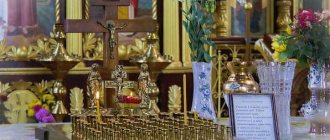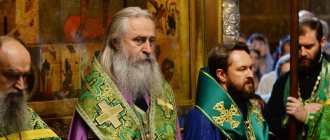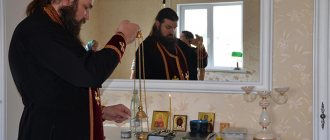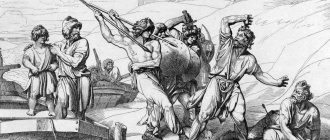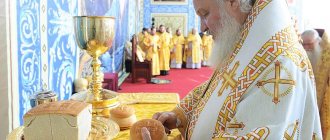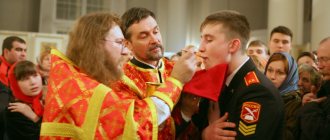- Scheme of the Liturgy Scheme of the Proskomedia
- Diagram of the Liturgy of the Catechumens
- Scheme of the Liturgy of the Faithful
- Normal start
See also articles and photo story about the Liturgy
Scheme of the Liturgy (consists of 3 parts):
1) Scheme of Proskomedia
- Removal of the Holy Lamb from the first prosphora.
- Placing the Lamb on the paten and filling the cup with wine and water.
- Removing particles from the other four prosphoras.
- Placing a star over the paten.
- Covering the paten and chalice with covers.
- Chopping of the cooked Lamb and particles.
- Reading a prayer for the acceptance of the Holy Gifts and release.
2) Scheme of the Liturgy of the Catechumens
- Initial exclamations from the deacon and priest.
- Great Litany.
- Psalm 1 pictorial “Bless the Lord, my soul” (102) (first antiphon).
- Small Litany.
- The second pictorial psalm (145) is “Praise, my soul, the Lord” (second antiphon).
- Singing the hymn “The Only Begotten Son and Word of God.”
- Small Litany.
- Singing the Gospel beatitudes and troparia “blessed” (third antiphon).
- Small entrance with the Gospel.
- Singing “Come Let Us Worship.”
- Singing the troparion and kontakion.
- The deacon’s cry: “Lord, save the pious.”
- Singing of the Trisagion.
- Prokimna singing.
- Reading of the Apostle. Singing alluary.
- Reading the Gospel.
- A special litany.
- Litany of the Catechumens.
- Litany with the command for the catechumens to leave the temple.
3) Outline of the Liturgy of the Faithful
- Abridged Great Litany.
- Singing the 1st part of the Cherubic Song and the priest reading the Great Entrance Prayer.
- Great Entrance and Transfer of the Holy Gifts.
- Singing the 2nd part of the Cherubic Song and placing the Holy Vessels on the Throne.
- 1st Petitionary Litany (About the offered, honest Gifts): preparation of those praying for the consecration of the Gifts.
- Exclamation: “Let us love one another, that we may be of one mind.”
- Singing the Creed. (after the exclamation “Doors, let us open the doors of wisdom”).
- The exclamation “Let’s become kind...”.
- Eucharistic prayer (3 parts).
- Consecration of the Holy Gifts (while singing: “We sing to you...”).
- Glorification of the Mother of God (“It is worthy to eat...”).
- Commemoration of the living and the dead (“And everyone, and everything...”).
- 2nd Petitionary Litany (On the Consecrated Honorable Gifts).
- Singing "Our Father".
- Ascension of the Holy Gifts. (“Holy of Holies…”).
- Communion of the clergy at the altar and the “sacramental” verse.
- The penultimate apparition of the Holy Gifts and Communion of the laity.
- The exclamation “Save, O God, Thy people” and the chant “We see the True Light.”
- The last appearance of the Holy Gifts and the chant “Let our lips be filled.”
- Litany of thanksgiving for Communion.
- Prayer behind the pulpit.
- “Be the name of the Lord” and the 33rd Psalm.
- The priest's last blessing.
Behavior rules
In church, during the service, you should behave calmly and quietly. You should arrive at the service ten to twenty minutes early in order to have time to bow to Christ. Silence should be maintained and gum should not be chewed. During the liturgy, hands should be free and should not be kept in pockets.
Men are required to remove their hats before entering the church premises, while women, on the contrary, should wear a headscarf in church. You should sing along with the choir quietly. Small children need to be monitored so that they do not run or make noise in the church, so as not to interfere with the service. Be sure to turn off mobile phones - loud sounds should not distract or disturb clergy and parishioners.
Scheme of the Liturgy of the Presanctified Gifts (served only during Lent)
- The cry of the deacon and priest: “Blessed is the kingdom”...
- Reading Psalm 103: “Bless the Lord, my soul.”
- Great Litany.
- Kathismas.
- Small Litany, or three small litanies (after each of the three kathismas), during which the transfer of the Holy Lamb from the Throne to the altar takes place.
- “The Lord cried.”
- Stichera “I cried to the Lord.”
- Evening entrance with censer (or with the Gospel, if required according to the Charter).
- “Quiet light”...
- Reading the first proverb.
- Shouts: “Wisdom, forgive me. The light of Christ enlightens everyone.”
- Reading the second proverb.
- Singing: “May my prayer be corrected.”
- Prayer of St. Ephraim the Syrian.
- Reading the Gospel (if required by the Charter).
- A special litany.
- Prayer for the Emperor.
- Litany of the Catechumens.
- Litany for the Enlightened. Exclamation: “For You are our enlightenment” (From the 4th week of Lent).
- Small litany of the faithful. The exclamation “As befits”...
- The second small litany is about the faithful.
- “Now are the powers of heaven.”
- Great Entrance with the Presanctified Gifts.
- The second part of the prayer: “Let us approach by faith and love.”
- Prayer of St. Ephraim the Syrian.
- Litany of petition.
- The Lord's Prayer “Our Father”.
- Exclamation: “The Holy One, Presanctified to the Saints.”
- The penultimate appearance of the Holy Gifts (“I will bless the Lord”).
- The last apparition of the Holy Gifts.
- Thanksgiving for Communion.
- Prayer behind the pulpit (“Lord Almighty”).
- “Blessed be the name of the Lord” (three times) and Psalm 33.
- The priest's last blessing.
- Vacation.
All-night vigil - what is it? Explanation of church services
As Anton Pavlovich Chekhov said through the mouth of Masha in the play “Three Sisters,” a person must be a believer or seek faith, otherwise everything is empty and makes no sense.
If thirty years ago for many the word “faith” was associated with “opium for the people,” now there are practically no people who have not encountered Christianity in one way or another, who have not gone to church and have not heard such words as liturgy, all-night vigil vigil, communion, confession, and so on.
This article will examine the concept of all-night vigil, or all-night vigil. This is a combination of three services: Vespers, Matins and the first hour. This service lasts on the eve of Sunday or before a church holiday.
Ancient Christians
The tradition of holding all-night vigils was introduced by the Lord Jesus Christ himself, who loved to devote the night hours to prayer. He was followed by the apostles and then by Christian communities.
It became especially important to gather at night and pray in the catacombs during the years of persecution of Christians. Saint Basil the Great called all-night services “agripnias,” that is, sleepless ones, and they spread throughout the East.
These agripnias were then performed all year round before Sunday, on the eve of Easter, on the feast of Epiphany (Epiphany) and on the days of honoring the holy martyrs.
Then the All-Night Vigil was a special service, on the creation of which great prayer books worked, such as St. John Chrysostom, St. John of Damascus, and Savva the Sanctified. The sequence of Vespers, Matins and the first hour has been almost completely preserved to this day.
The concept of the All-Night Service
Clergymen are often asked the question: “Is it obligatory to go to all-night vigils?” Believers feel that this service is more difficult to endure than the liturgy. And this happens because the All-Night Vigil is a person’s gift to God.
At it, everyone present sacrifices something: their time, some life circumstances, and the liturgy is God’s sacrifice to us, so it is easier to endure, but often the degree of acceptance of the Divine sacrifice depends on how much a person is ready to give, sacrifice something God.
The Russian Orthodox Church has preserved in its entirety the very complex, beautiful, spiritual all-night vigil. The liturgy, celebrated on Sunday morning, completes the weekly cycle. In Russian churches, the evening service is combined with the morning one, and all this happens in the evening. This was introduced by the church fathers, and this rule allows us to remain faithful to the apostolic tradition.
How they serve outside Russia
For example, in Greece there is no all-night vigil, there is no vespers; matins begins in the morning and, together with the liturgy, takes only two hours. This happens because modern people are less prepared physically and spiritually for service. Many do not understand what is read and sung in the choir; Unlike their ancestors, contemporaries know little about the Lord Jesus Christ and the Mother of God.
In a word, everyone decides for himself whether he will go to the all-night service or not. There are no strict rules; clergy do not impose “unbearable burdens” on people, that is, what is beyond their strength.
Sometimes events in the life of a believer do not allow him to attend the all-night vigil (urgent work, a jealous husband (wife), illness, children, etc.), but if the reason for absence is not valid, then such a person better think carefully before proceeding to accept Christ’s Tain.
Follow-up of the All-Night Vigil
The temple is a place of prayer for Christians. In it, the ministers pronounce various types of prayers: both petitionary and repentant, but the number of thanksgiving ones exceeds the rest. The Greek word for thanksgiving is Eucharist.
This is what Orthodox Christians call the most important sacrament present in their lives - this is the sacrament of communion, which is performed at the liturgy, and before that everyone must prepare for communion.
You need to fast (fast) for at least three days, think about your own life, correct it by confessing to the priest, read the prescribed prayers, eat or drink nothing from midnight until communion.
And all this is just the minimum of what a believer should do. In addition, it is advisable to go to the all-night vigil service, which begins with the striking of the bells.
In an Orthodox church, the central place is occupied by the iconostasis - a wall decorated with icons. In its center there are double doors, also with icons, otherwise called the Royal or Great Gates. During the evening service (at first), they are opened, and an altar with a seven-branched candlestick on the throne (the table on which the most sacred and mysterious actions are performed) appears before the believers.
Beginning of the evening service
The all-night service begins with Psalm 103, which remembers the six days created by God.
While the singers sing, the priest burns incense throughout the temple, and the smell of incense, the solemn chant, the calm, majestic movements of the clergy - all this recalls the comfortable life of Adam and Eve in paradise before their fall.
Then the priest enters the altar, closes the doors, the choir falls silent, the lamps go out, the chandelier (chandelier in the center of the temple) - and here one cannot help but remember the fall of the first people and the fall of each of us.
Since ancient times, people have longed to pray at night, especially in the East. The summer heat and the exhausting heat of the day did not encourage prayer. Another thing is the night, during which it is pleasant to turn to the Almighty: no one interferes, and there is no blinding sun.
Only with the arrival of Christians did the all-night service become a form of public service. The Romans divided the night time into four watches, that is, into four shifts of military guard. The third watch began at midnight, and the fourth at rooster crow. Christians prayed all four watches only on special occasions, for example, before Easter, but usually they prayed until midnight.
All-night hymn
An all-night vigil without psalms is unthinkable; they permeate the entire service. The singers read or sing psalms in whole or in fragments. In a word, the psalms are the skeleton of the all-night vigil; without them it would not exist.
The hymns are interrupted by litanies, that is, petitions, when the deacon, standing in front of the altar, asks God for forgiveness of our sins, for peace in the whole world, for the unification of all Christians, for all Orthodox Christians, for travelers, the sick, for deliverance from sorrow, troubles and etc. In conclusion, the Mother of God and all the saints are remembered, and the deacon asks that we all “devour our whole belly,” our lives, to Christ God.
During Vespers, many prayers and psalms are sung, but at the end of each stichera a dogmatism is always sung, which tells that the Mother of God was a Virgin both before the birth of Christ and then. And Her birth is joy and salvation for the whole world.
The All-Night Vigil is a service during which blessings to God are often pronounced. Why do we say these words, because God does not need either our kind words or our songs? And indeed, the Lord has everything, all the fullness of life, but we need these kind words.
There is one comparison that was made by a Christian writer. A beautiful painting does not need praise, it is already beautiful. And if a person does not notice it, does not pay tribute to the artist’s skill, then he is thereby robbing himself. The same thing happens when we don’t notice God, we don’t give thanks for our lives, for the created world around us. This is how we rob ourselves.
Remembering the Creator, a person becomes kinder, more humane, and forgetting about Him, he becomes more like a humanoid animal, living by instincts and the struggle for survival.
During the evening service, one prayer is always read, personifying the Gospel event. These are “Now you let go...” - the words spoken by Simeon the God-Receiver, who met the baby Jesus in the temple and told the Mother of God about the meaning and mission of her Son. Thus, the all-night vigil (“meeting”, meeting) glorifies the meeting of the Old Testament and New Testament worlds.
Six Psalms
After this, the candles (lamp) in the temple are extinguished, and the reading of the Six Psalms begins. The temple plunges into darkness, and this is also symbolic, as it recalls the darkness in which the Old Testament people lived who did not know the Savior. And on this night the Lord came, as once on Christmas night, and the angels began to praise Him by singing “Glory to God in the highest.”
This period during the service is so important that, according to the Church Charter, during the Six Psalms they do not even bow or make the sign of the cross.
Then the Great Litany (petition) is pronounced again, and then the choir sings “God is the Lord and appeared to us...”. These words recall how the Lord, at the age of thirty, entered His Service, for the sake of which He came into this world.
Hallelujah
After some time, the candles are lit and the polyeleos begins, with the choir singing “Hallelujah.” The priest goes to the middle of the temple and, together with the deacon, censes the temple with fragrant incense. Excerpts from the psalms are then sung, but the climax of the all-night vigil is the reading of the Gospel by the priest.
The Gospel is taken out of the altar, as if from the Holy Sepulcher, and placed in the middle of the temple.
The words spoken by the priest are the words of the Lord himself, therefore, after reading, the deacon holds the Holy Book, like an Angel proclaiming the news of Christ, the Savior of the world.
The parishioners bow to the Gospel like disciples and kiss it like the myrrh-bearing women, and the choir (ideally the whole people) sings “Having seen the Resurrection of Christ...”.
After this, the 50th repentant psalm is read, and the clergy anoint the forehead of each person with consecrated oil (oil) in a cross shape. This is followed by reading and singing of the canon.
The attitude of contemporaries to the church
Modern people have begun to treat the church as something good, useful, but which has already had its say. They don’t see anything new in it; they often ask idle questions.
Why go to church so often? How long does the all-night vigil last? Church life is incomprehensible to those who rarely go to church. And the point is not in the Church Slavonic language in which the service is conducted.
The church's position itself is unacceptable to many people.
The Russian Orthodox Church reminds the world of the meaning of existence, of family, marriage, morality, chastity, of everything that people forget about when they sit comfortably in front of the TV. The church is not clergy or beautiful walls. The Church is a people bearing the name of Christ who gather together to glorify God. This is an important message to a world that lies in lies.
All-night vigil, liturgy, reception of the Holy Mysteries, confession - these are the services that people need, and those who understand this strive for the “ark of the Lord.”
Conclusion
After the canon at the all-night vigil, the stichera on the Praiseworthy are read, and then the Great Doxology. This is the majestic singing of a Christian hymn. It begins with the words “Glory to God in the Highest and on earth Peace...”, and ends with the trisagion: “Holy God, Holy Mighty, Holy Immortal, have mercy on us,” pronounced three times.
This is followed by litanies, Many Years, and at the end the “First Hour” is read. Many people leave the temple at this time, but in vain. In the prayers of the first hour, we ask God to hear our voice and help us continue the day.
It is desirable that the temple becomes for everyone a place where they want to return. So that you can live the rest of the week in anticipation of a meeting, a meeting with the Lord.
Source: //fb.ru/article/306970/vsenoschnaya—eto-chto-takoe-razyyasnenie-tserkovnogo-bogoslujeniya
Scheme of Matins at the All-Night Vigil
- Six Psalms (Psalms 3, 37, 62, 87, 102, 142).
- Great Litany.
- “God is the Lord and appear to us.”
- Troparion for Sunday or holiday or Saint.
- Reading kathismas.
- Small Litany.
- Polyeleos (“Praise the name of the Lord”).
- Sunday “blameless” troparia (“Blessed art thou, O Lord”).
- Greatness (on great holidays).
- Small Litany.
- Sedalna or ipakoi.
- Sedate (on the occasion of great holidays, antiphon 4 voices: “From my youth”)...
- Reading the Gospel.
- “Having seen the Resurrection of Christ.”
- The deacon’s exclamation “Save, O God, Thy people”...
- Canon (small litanies on the 3rd and 6th cantos).
- “My soul magnifies the Lord.”
- Exapostillary or luminary.
- “Let every breath praise the Lord” and stichera on those who praise.
- Theotokos: “Blessed are you, the Virgin Mary” (textbook of Hours).
- Great doxology.
- Sunday troparion of dismissal or holiday troparion.
- A special litany.
- Litany of petition.
- Vacation.
- First Hour (see diagram of the Hours).
Scheme of Great Compline.
First part.
- The usual start.
- “Come, let us worship” and Psalm 69 (See the Teachings of the Book of Hours).
- Canon of St. Andrew of Crete (in the first 4 days of Lent).
- Six psalms: 4, 6, 12, 24, 30, 90.
- "God is with us".
- Troparion: “The day is past, I thank You, Lord.”
- Symbol of faith.
- Prayer: “To the Most Holy Lady.”
- Trisagion according to “Our Father”.
- Troparion and Theotokos (Various by day of the week).
- “Lord have mercy” 40 times; prayers of absolution: “Glory even now,” “Most honorable Cherub,” etc.
- Prayer “Lord, deliver us from every arrow that flies throughout the days.”
Second part.
- “Come, let us worship” (three times), Psalms 50 and 101;
- Prayer of Manasseh: “Lord Almighty, God of our fathers.”
- Trisagion according to “Our Father”.
- Troparion: “Have mercy on us, Lord, have mercy on us.”
- “Lord have mercy” 40 times and the same prayers of absolution.
- Prayer: “Sovereign God, Father Almighty”...
The third part.
- “Come, let us worship” (three times).
- Psalms 69 and 142 and the Great Doxology.
- Trisagion according to “Our Father”.
- Canon private.
- Singing: “Lord of strength be with us.”
- “Lord have mercy” 40 times. Prayer: “For every time and every hour” and the same prayers of dismissal.
- “Lord and Master of my life”...
- Prayer: “Undefiled, unblasphemous”...
- “And grant us, O Master, our future sleep”..., “Glorious Ever-Virgin”, “My Father’s Hope.”
- Great holiday. Reading sacred they say “The Lord is most merciful.”
- A special litany.
Schedule and types of services in the Orthodox Church
The church opens early in the morning. Evening and morning services are held on Sundays and Orthodox holidays. The morning service begins, as a rule, at seven or eight o'clock in the morning. The evening liturgy begins at seven or eight o'clock in the evening. Night services are held only on major holidays, such as Epiphany and Easter.
The duration of the service depends on the scale of the celebration. Each day of the week in the Christian calendar is dedicated to a specific event. Each of the ministries, in turn, consists of three parts.
Sunday
The liturgical week begins with Sunday service. Sunday is a weekly holiday on which it is customary to celebrate the resurrection of Christ the Savior. This day is also called Little Easter.
In Orthodox scriptures, Sunday is often referred to as “week.” This is due to the fact that on this day it is not customary to engage in everyday affairs, but should be dedicated to prayer and reading spiritual books.
Monday
On Monday, the temple glorifies angels, God's closest servants, created before man. Angels are disembodied spirits, but sometimes the Lord allows them to appear in bodily form in order to reveal the will of God to people. In some monasteries it is customary to observe fasting on Monday. Angels are revered in a special way, since monks, like them, devote their lives to serving the Lord.
Tuesday
On Tuesday, the church glorifies the righteous of the Old Testament, who, through their faithfulness to the Lord, contributed to the birth of the Savior. In particular, the Holy Prophet, Forerunner and Baptist of the Savior John is glorified.
John was the closest predecessor of Jesus Christ, who predicted his coming. During his lifetime, he himself was an ascetic living in the desert, and performed the ablutions of the Jews, which later became known as the sacrament of baptism. Considered to be the last of the prophets and harbingers of the Messiah.
Wednesday
On Wednesday, it is customary to remember the Apostle Judas Iscariot, who betrayed Jesus Christ for thirty pieces of silver, thereby dooming him to certain death. In the Orthodox Church, Wednesday is a day of fasting. Most of the hymns on this day are dedicated to the Life-Giving Cross and the Most Pure Mother of God.
It is believed that Jesus died for the sins of people, being a man himself, so that the children of God would be spared from eternal death and would have the opportunity to enter God's Kingdom. Also on Wednesday, they remember the Last Supper, on which the Lord told his disciples the secrets of death on the cross and the Resurrection.
Thursday
On this day of the week, the apostles are traditionally glorified, who preached the Word of God throughout the world and contributed to the fact that many people turned their hearts to Jesus Christ. The apostles died the death of martyrs, and after their death the Christian faith spread throughout the world, and the number of people who converted to Christianity was constantly growing.
In particular, the personification of the apostles is Nicholas the Wonderworker. Nicholas was famous as the patron of sailors, the pacifier of warring parties, the protector of those illegally convicted and the deliverer from accidental death. In the modern Russian church, Nicholas the Wonderworker is considered the most revered saint. Most of the church singing on Thursday is dedicated to him.
Friday
On Friday, Christians remember the martyrdom of Jesus Christ on Calvary. Just like Wednesday, Friday is a fast day, and on this day it is also customary to pray to the Life-Giving Cross. The death of Christ is a symbol of redemption and salvation of people from eternal death. On Friday, churches glorify the Most Holy Theotokos in her sorrow.
Saturday
On the last day of the week, the Orthodox Church remembers all the saints. The Blessed Virgin Mary, the Mother of God, is especially venerated in the Saturday service. On Saturday it is customary to remember the departed, as well as Jesus Christ himself, his stay in the tomb and victory over death. We remember all the servants of God who left our world and are enjoying bliss in the heavenly world.
At the end of the week, the weekly liturgical cycle ends and begins anew, thereby returning us to the same events, allowing us to comprehend the spiritual world more and more deeply.
During weekdays
In most Orthodox churches, evening and daytime liturgies are not celebrated daily on weekdays. On weekdays only morning services are held. In some churches, services are held every day. During Lent, weekday liturgies are usually held only on Wednesday and Friday, and on Saturday and Sunday they take place as always. In many churches, Lenten weekday services are held in the afternoon.
Clock diagram
- The usual start.
- Three Psalms.
- At the 1st hour - 5, 89 and 100;
- At the 3rd hour - 16, 24, 50;
- At the 6th hour - 53, 54, 90;
- At the 9th hour - 83, 84 and 85 ps.
- Glory even now, alleluia.
- Troparion of an hour, holiday or Saint.
- Theotokos.
- Trisagion according to “Our Father”. Kontakion of a holiday or Saint.
- “Lord have mercy” 40 times.
- Prayer: “For every time and every hour.”
- “Lord have mercy” 3 times.
- “Glory even now.” “The most honorable Cherub.”
- Blessing of the priest.
- Closing prayer to the Lord Jesus.
Scheme of Vespers at the All-Night Vigil
- Exclamation of the deacon and priest.
- Opening Psalm 103 “Bless my soul the Lord.”
- Great Litany.
- Psalm: “Blessed is the man who does not follow the counsel of the wicked.”
- Small Litany.
- “The Lord cried.”
- Stichera on “I cried to the Lord”...
- Dogmatist or Mother of God.
- Evening entrance (with censer).
- Singing the hymn: “Quiet Light.”
- Prokeimenon of the day.
- Reading paroemias (3 paroemias). (On the eve of great and temple holidays).
- A special litany.
- Prayer: “Lord grant”...
- Litany of petition.
- Stichera on lithium.
- Lithium. (On the eve of great and temple holidays).
- Poems on poems,
- “Now you forgive”, Trisagion according to “Our Father”.
- Troparion or (on Sundays) “To the Virgin Mary.”
- Blessing of the loaves. (On the eve of great and temple holidays.).
- “Blessed be the Name of the Lord” and Psalm 33.
- Blessing of the priest.
Annual circle
This cycle does not have its own services. The texts of the annual circle are inserted into the daily ceremonies. The annual cycle includes the Months and Easter.
Every day
The unchanged texts of the rituals that make up the Daily Circle are read daily. The ceremony includes modified prayers from the weekly and annual circle. Every day of God is dedicated to some significant event in Orthodoxy.
In honor of such dates, prayers, chants, various readings, and rituals are established.
Easter
On such a day the Resurrection of Christ is glorified. The most important celebration, not dedicated to any specific date. Refers to the mobile ones. Celebrated no earlier than April 4 and no later than May 8.
Twelfth holidays
There are only 12 most important holiday events. They are called the twelve, they can be moving (depending on Easter) or fixed (with a precisely set date). These do not include Easter.
Fixed:
- Nativity of the Virgin Mary (September 21);
- Exaltation of the Holy Cross (September 27);
- Entrance to the Church of the Blessed Virgin Mary (December 4);
- Nativity of Christ (January 7);
- Epiphany (January 19);
- Presentation of the Lord (February 15);
- Annunciation of the Virgin Mary (April 7);
- Transfiguration of the Lord (August 19);
- Dormition of the Blessed Virgin Mary (August 28).
Movable:
- Entry of the Lord into Jerusalem;
- Ascension of the Lord;
- Pentecost.
Great Saints and Angels
Every day we remember the great martyrs who gave their lives for the glory of the Almighty. A description and list of all significant holidays dedicated to the holy great martyrs and angels is necessarily printed in the church calendar.
Classification
Holiday church events are grouped and classified. At services held daily for twelve months, texts prescribed by the Charter are read, as well as prayers on the occasion of holidays that fall on a certain date. On particularly special days, the ritual of the service changes somewhat.
Fixed and movable
The month consists of fixed holidays, each of which is comparable to a precisely established day of the month. The month begins at the beginning of the church year, that is, on September 1. The main fixed holidays are called the twelfths (there are only nine of them). The monthly word includes 3 posts.
Easter is a system of moving holiday events. First of all, it's Easter. Easter is not tied to any exact date, but is celebrated annually and depends on the day on which Easter falls. Before the Resurrection of Christ there is Great Lent, which lasts six weeks. There are 3 twelve holidays on Easter. Easter begins 3 weeks before Lent. Ends with the Sunday of All Saints, which is celebrated after Pentecost.
By solemnity
The main holiday is Easter. She doesn't belong to any category. On such a day, the Easter service is held - a ceremony at which all texts are mainly sung.
Great
The category of great ones includes the Twelve, there are 12 of them in total. Believers solemnly celebrate all events from the earthly life of the Almighty, as well as those associated with his divine Resurrection. 5 non-twelfth dates are also considered great.
Average
Such festivities are established in honor of saints, icons of the Immaculate Virgin, or events important to the Church. Nobody knows their number.
Small
Days in Orthodoxy are dedicated to great martyrs or saints who devotedly served the faith, as well as events from church life.
There are dates when several minor holidays are celebrated at once.

